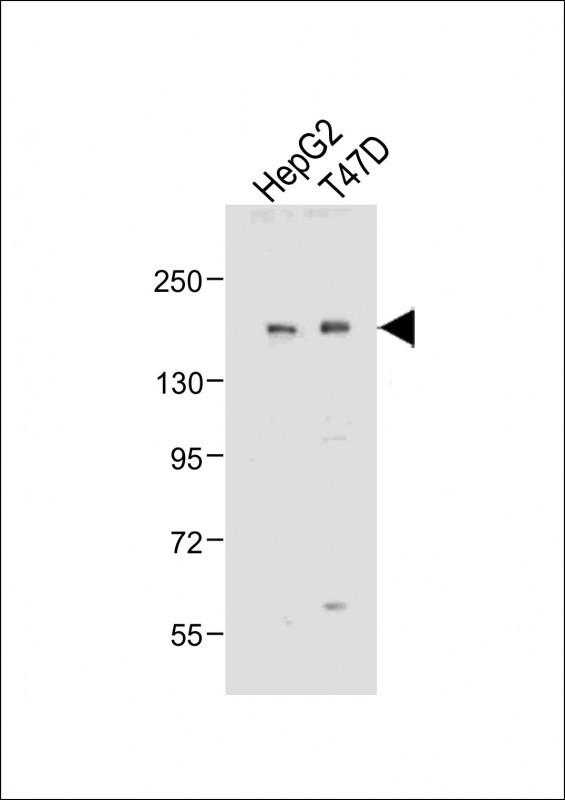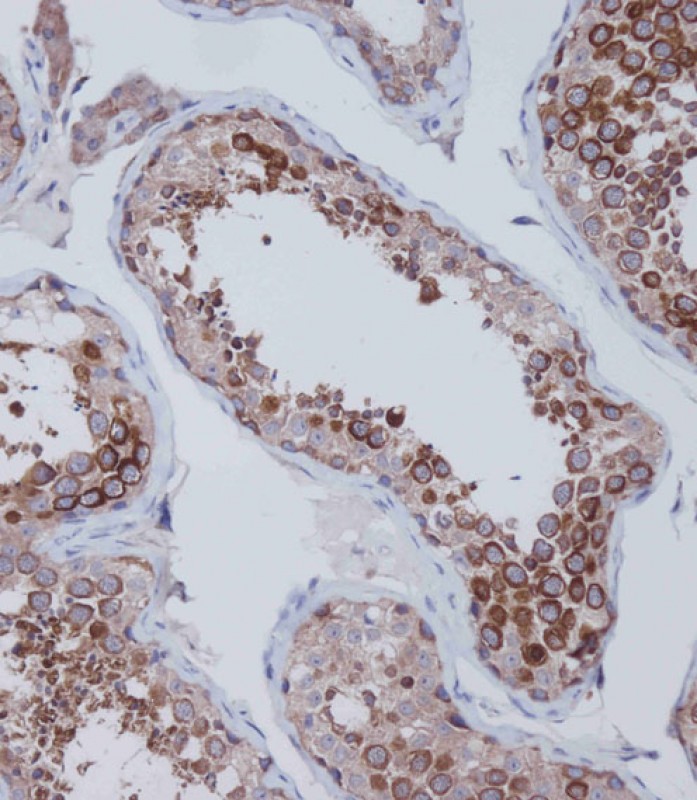

| WB | 咨询技术 | Human,Mouse,Rat |
| IF | 咨询技术 | Human,Mouse,Rat |
| IHC | 1/100-1/500 | Human,Mouse,Rat |
| ICC | 技术咨询 | Human,Mouse,Rat |
| FCM | 咨询技术 | Human,Mouse,Rat |
| Elisa | 咨询技术 | Human,Mouse,Rat |
| Aliases | Histone deacetylase 6, HD6, HDAC6, KIAA0901 |
| Entrez GeneID | 10013 |
| WB Predicted band size | 131.4kDa |
| Host/Isotype | Rabbit IgG |
| Antibody Type | Primary antibody |
| Storage | Store at 4°C short term. Aliquot and store at -20°C long term. Avoid freeze/thaw cycles. |
| Species Reactivity | Human, Mouse |
| Immunogen | This HDAC6 antibody is generated from rabbits immunized with a KLH conjugated synthetic peptide between 1182-1215 amino acids from the C-terminal region of human HDAC6. |
| Formulation | Purified antibody in PBS with 0.05% sodium azide,1%BSA and 50% glycerol.prepared by Saturated Ammonium Sulfate (SAS) . |
+ +
以下是3篇关于HDAC6抗体的代表性文献,按领域分类整理:
1. **文献名称**:*HDAC6 regulates antigen-selective responses in CD4+ T cells*
**作者**:Villagra A et al. (2009)
**摘要**:研究利用HDAC6特异性抗体发现,HDAC6通过调控微管稳定性影响T细胞受体信号传导,提示其在免疫反应中的关键作用。
2. **文献名称**:*Selective inhibition of HDAC6 promotes clearance of amyloid-β in Alzheimer's disease models*
**作者**:Simões-Pires C et al. (2013)
**摘要**:通过HDAC6抗体检测发现,抑制HDAC6可增强细胞自噬功能,促进阿尔茨海默病模型中的β淀粉样蛋白清除。
3. **文献名称**:*HDAC6 modulates cell motility by altering the acetylation level of cortactin*
**作者**:Zhang X et al. (2007)
**摘要**:使用HDAC6特异性抗体证实,HDAC6通过去乙酰化修饰cortactin蛋白调控肿瘤细胞迁移能力,揭示其与癌症转移的关联。
4. **文献名称**:*Development of a novel HDAC6-specific antibody for studying tauopathy pathogenesis*
**作者**:Li Y et al. (2020)
**摘要**:报道新型高特异性HDAC6抗体的开发,验证其在tau蛋白病理模型中的应用潜力,为神经退行性疾病研究提供工具。
---
**领域交叉点**:这些研究覆盖免疫学(1)、神经科学(2.4)和癌症生物学(3),均通过HDAC6抗体揭示其在不同疾病中的分子机制。方法学上均涉及抗体介导的蛋白质互作或修饰检测,提示HDAC6抗体在机制研究中的核心工具价值。
HDAC6 (Histone Deacetylase 6) is a unique member of the histone deacetylase family, primarily localized in the cytoplasm and distinguished by its two catalytic domains and a zinc finger ubiquitin-binding domain. Unlike other HDACs, HDAC6 mainly targets non-histone substrates, including α-tubulin, HSP90. cortactin, and peroxiredoxins, regulating processes such as cell motility, protein degradation, stress response, and immune synapse formation. Its involvement in critical cellular pathways has linked HDAC6 dysregulation to various diseases, including cancer, neurodegenerative disorders (e.g., Alzheimer’s and Parkinson’s), and inflammatory conditions.
HDAC6 antibodies are essential tools for studying its expression, localization, and functional roles. These antibodies enable the detection of HDAC6 in techniques like Western blotting, immunohistochemistry, immunofluorescence, and co-immunoprecipitation. Specific HDAC6 inhibitors, such as tubacin and ACY-1215. are often used alongside antibodies to explore therapeutic potentials. Researchers also utilize HDAC6 antibodies to validate knockdown efficiency in siRNA or CRISPR experiments and to investigate post-translational modifications or interactions with binding partners.
Given HDAC6's therapeutic promise, its antibodies are vital for preclinical research, aiding in biomarker discovery and mechanistic studies. Commercial HDAC6 antibodies are typically validated for species reactivity (human, mouse, rat) and application-specific performance, though variability between clones necessitates careful selection. Ongoing studies continue to clarify HDAC6's dual roles in promoting or suppressing diseases, underscoring the importance of reliable antibody tools in advancing targeted therapies.
×